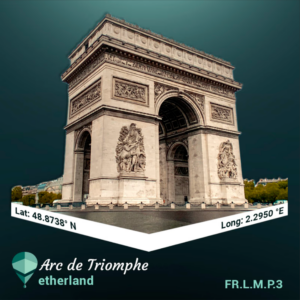 The Arc de Triomphe is an impressive piece of architecture standing 50 meters tall and located in Paris, France. It was built in 1806 to honor those who died in the Napoleonic wars and celebrates France's withstanding and resilience. This massive triumphal arch was born out of elegant Roman architecture yet remains an important part of France's identity. Also known as 'Place de l'Étoile', it is the center of 12 lively avenues radiating out of it and giving it its star-like shape. The Arc de Triomphe is definitely considered one of the most prestigious and iconic landmarks of Paris.
The Arc de Triomphe is an impressive piece of architecture standing 50 meters tall and located in Paris, France. It was built in 1806 to honor those who died in the Napoleonic wars and celebrates France's withstanding and resilience. This massive triumphal arch was born out of elegant Roman architecture yet remains an important part of France's identity. Also known as 'Place de l'Étoile', it is the center of 12 lively avenues radiating out of it and giving it its star-like shape. The Arc de Triomphe is definitely considered one of the most prestigious and iconic landmarks of Paris.
Though known widely by its shorthand name, the Arc de Triomphe, the Triumphal Arch’s full name is the Arc de Triomphe de l’Étoile, or the Triumphal Arch of the Star. It is an enormous monumental arch which stands fifty metres high at the western end of the Champs-Élysées in central Paris. The ‘Star’ in the title refers to the fact that numerous avenues and streets radiate outwards from the Place Charles de Gaulle which the Arc stands at the centre of and which was previously known as the Place de l’Étoile.
The Arc was commissioned in 1806 by the Emperor of France, Napoleon Bonaparte, and work began that same autumn on Napoleon’s birthday, the 15th of August. It was initially conceived of as a triumphal arch to commemorate his highly significant French military victory over Austria and Russia at the Battle of Austerlitz in modern-day Czechia on the 2nd of December 1805, however its meaning was soon broadened to stand as a memorial to France and its triumphant ascendancy over Europe since the French Revolution of 1789, the country having come to dominate the continent by the early nineteenth century.
The arch was designed by Jean-Frannçois-Thérèse Chalgrin who built the arch along Neo-Classical (Roman and Greek) lines, having been inspired by the Arch of Titus in the Forum in Rome. The arch is decorated by large relief sculptures which depict scenes of French Revolutionary armies of the 1790s and Napoleon’s imperial armies of the 1800s and their victories over the great European powers such as Britain, Austria, Russia and Prussia. Other parts of the Arc contain lists of French generals and battles which they had won in the 1790s and 1800s. There is furthermore an observation deck at the top of the arch which can be reached by a stairway consisting of 284 steps and which gives a panoramic view of the North Bank and Paris near the Seine.
Work on the Arc progressed slowly in the years that followed as the wars in Europe turned against France and Napoleon. Consequently the arch took thirty years to complete and it was only officially opened by King Louis-Philippe on the 29th of July 1836. The Arc has been added to in subsequent times, most famously in 1921 when the Tomb of the Unknown Soldier was added beneath the arch to commemorate French soldiers who had died during the First World War and who had not been buried or identified. A flame which was added to the tomb in 1923 is relit every evening to this day.
The Arc remains one of the most recognisable and iconic monuments in Paris, not least because the arch is used regularly as a backdrop for parades and events on the Champs-Élysées, notably by the Allies following the liberation of Paris in August 1944. Today it is used as the end point for the annual Tour de France and the start point for the Bastille Day celebrations every July 14 and over a million and a half tourists visit the Arc every year.